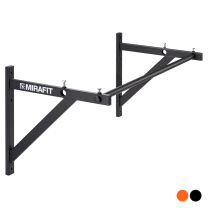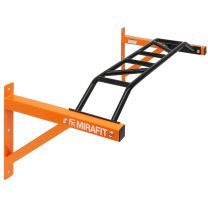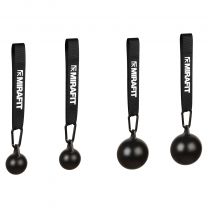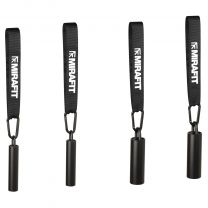Pull Up Bar Workout For Beginners
Pull Up Bar Workout For Beginners

There’s no denying it, pull ups are hard.
And it doesn’t matter whether you’re familiar with a pull up bar, or can’t do a single rep, pull ups take a long time to master. And you need to put the work in to get better at them – whatever stage you’re at.
The term ‘pull up’ refers to a whole range of exercises that involve using a pull up bar.
Pull Up Bars can be either wall or ceiling mounted, or you can find them on equipment such as power racks and gym towers.
They’re a great way to train at home. And by doing pull up exercises regularly, you’ll be able to build strength, as well as improve your technique and form.
Pull up basics

• The most basic form of a pull up is the classic chin up. To do these
• Start in a dead hang with your hands on the Pull Up Bar, slightly wider than shoulder width apart
• Lower your shoulders to bring you up into an active hang
• Lift your body up until your chin meets the bar – remember to keep your body straight as you pull up
• Lower yourself back down in a controlled manner.
• Don’t jump up to grab the bar. Use a Weight Bench or a Plyo Jump Box to help you up onto the bar to avoid straining your shoulder and wrist joints.
Improving your pull ups

When doing pull ups, there are a few training techniques that will help you build strength and improve:
• Keep your spine straight - keeping your back straight is really important when doing traditional pull ups. A stretched back will decrease the amount you can strengthen it by and will also put you at risk of injury.
• Pull with your back - it's quite common to see people engaging their arms instead of their back when doing pull ups. If this sounds familiar, you're either lifting too much weight or you haven't learnt to engage your back properly yet (or both).
Squeeze your back muscles into position so they're tense and then lift using these muscles, so you can really feel it in your back. If this is too difficult to do, pop a weight bench behind you so you can use it to support your weight slightly and 'hop up' into your pull up position.
• Negative pulls - negative pulls are just as important as pull ups and are great for helping you get stronger. Once in your fully raised position, lower yourself down slowly back into a hang position, concentrating on your back working the whole way.
On a side note, hanging from the bar and then lifting yourself up slightly - just so you're in that tensed position with your shoulder blades lowered - is ideal for strengthening your scapula and improving your pull up technique.
• Include isometric training - isometric training refers to a particular type of muscle contraction that occurs when the muscle is not changing length. You can do this by holding pull ups at different angles for 5-10 seconds, so your muscles are tensed the whole time without moving. This will really optimise your strength training and help you develop your pull up technique.
You can also supplement your training with a range of exercises such as
• Lat pulldowns
• Upward rows
• Seated rows
• Hang toughs
• Assisted pull ups (using a Resistance Band)
• Shrugs
Pull up variations

Once you're happy with your traditional style pull up, it's time to add in some variety. Below are our top pull up variations for you to try at home:
1 - Around the world
Targets: biceps and back, one arm at a time
How to do them: start in your active hang position with a wide grip. Then pull your body up towards your right hand, move across to your left while still in a raised position and then drop back down to your starting position. Change direction halfway through.
Why they're great: one step away from one arm pull ups, these are great for building strength on each side as you place nearly all your body weight onto one side.
2 - Clapping pull ups
Targets: explosivity and grip
How to do them: pull yourself up to the bar quickly and with power. Then, while you're up, momentarily take your hands off the bar and clap them together, before catching the bar and lowering yourself back down in a controlled manner.
Why they're great: by doing explosive pull ups, you're training your nervous system as well as your muscles so that you can really fire up your movements and develop a quicker, more powerful pull up.
3 - Negative pull ups
Targets: biceps and back
How to do them: raise yourself up into a pull up and then lower yourself down as slowly as possible. You can try counting down to 10 as you descend to help maintain consistent reps.
Why they're great: negative pull ups are really beneficial because they tax your muscles to a greater degree than normal pull ups. By moving back down in a controlled way, you're resisting the lengthening of your muscles so you are tearing more fibres. And this equals greater strength.
4 - Towel pull ups
Targets: grip strength
How to do them: hang a towel over the pull up bar so it's even at both ends. Then grab each end with each hand and pull yourself up. Make sure you use a towel that is thick enough to handle the exercise.
Why they're great: unlike the pull up bar, towels not only move around so it's more difficult to remain stable (working your core), but it's really hard to maintain your grip so holding on really helps you to develop this.
Grip strength will help you in all sorts of other exercises as well – on the pull up bar, with a barbell, dumbbell and when you're doing dips, bench presses and squats too.
5 - L-sits
Targets: lower core, quads, arms, back and shoulders, as well as hip flexors
How to do them: bring yourself up into an active hang and then raise your legs up so that they're at a right angle to your body. Keep your spine straight and pause. Then lower back down in a controlled manner.
Why they're great: pull up bars aren't just about working your upper body. They're a great excuse to get in some lower core work too. L-sits allow you to train your abs, quads and hips, while maintaining an active hang.
The best thing about doing these variations is that they help you to perfect your pull up technique. And by trying out different styles, you’ll be training your nervous system, grip and muscles, as well as improving your explosivity.
Read more about training your Upper Body using resistance bands.
For more content, follow us on Instagram, YouTube, TikTok, and on our official Mirafit Facebook page.
Enter your email to signup to our newsletter
Tags: Equipment > Pull Up Bar ; Exercise Type > Strength ; Misc > Workout







